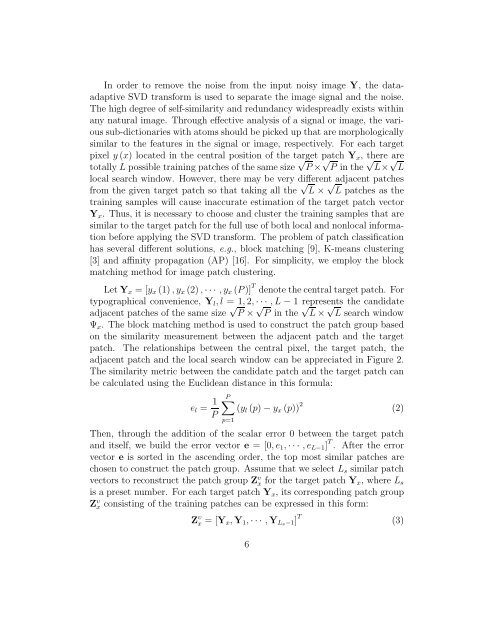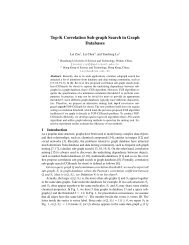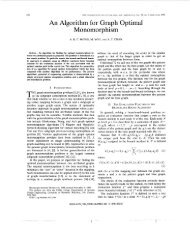Elsevier Editorial System(tm) for Information Sciences Manuscript ...
Elsevier Editorial System(tm) for Information Sciences Manuscript ...
Elsevier Editorial System(tm) for Information Sciences Manuscript ...
You also want an ePaper? Increase the reach of your titles
YUMPU automatically turns print PDFs into web optimized ePapers that Google loves.
In order to remove the noise from the input noisy image Y, the dataadaptive<br />
SVD trans<strong>for</strong>m is used to separate the image signal and the noise.<br />
The high degree of self-similarity and redundancy widespreadly exists within<br />
any natural image. Through effective analysis of a signal or image, the varioussub-dictionaries<br />
withatomsshould bepicked upthataremorphologically<br />
similar to the features in the signal or image, respectively. For each target<br />
pixel y(x) located in the central position of the target patch Y x , there are<br />
totallyLpossible training patches of the same size √ P× √ P in the √ L× √ L<br />
local search window. However, there may be very different adjacent patches<br />
from the given target patch so that taking all the √ L× √ L patches as the<br />
training samples will cause inaccurate estimation of the target patch vector<br />
Y x . Thus, it is necessary to choose and cluster the training samples that are<br />
similar to the target patch <strong>for</strong> the full use of both local and nonlocal in<strong>for</strong>mation<br />
be<strong>for</strong>e applying the SVD trans<strong>for</strong>m. The problem of patch classification<br />
has several different solutions, e.g., block matching [9], K-means clustering<br />
[3] and affinity propagation (AP) [16]. For simplicity, we employ the block<br />
matching method <strong>for</strong> image patch clustering.<br />
LetY x = [y x (1),y x (2),··· ,y x (P)] T denotethecentraltargetpatch. For<br />
typographical convenience, Y l ,l = 1,2,··· ,L − 1 represents the candidate<br />
adjacent patches of the same size √ P × √ P in the √ L× √ L search window<br />
Ψ x . The block matching method is used to construct the patch group based<br />
on the similarity measurement between the adjacent patch and the target<br />
patch. The relationships between the central pixel, the target patch, the<br />
adjacent patch and the local search window can be appreciated in Figure 2.<br />
The similarity metric between the candidate patch and the target patch can<br />
be calculated using the Euclidean distance in this <strong>for</strong>mula:<br />
e l = 1 P∑<br />
(y l (p)−y x (p)) 2 (2)<br />
P<br />
p=1<br />
Then, through the addition of the scalar error 0 between the target patch<br />
and itself, we build the error vector e = [0,e 1 ,··· ,e L−1 ] T . After the error<br />
vector e is sorted in the ascending order, the top most similar patches are<br />
chosen to construct the patch group. Assume that we select L s similar patch<br />
vectors to reconstruct the patch group Z υ x <strong>for</strong> the target patch Y x, where L s<br />
is a preset number. For each target patch Y x , its corresponding patch group<br />
Z υ x consisting of the training patches can be expressed in this <strong>for</strong>m:<br />
Z υ x = [Y x ,Y 1 ,··· ,Y Ls−1] T (3)<br />
6












